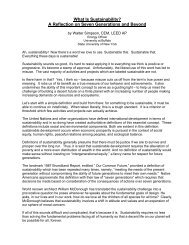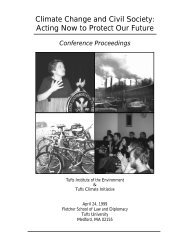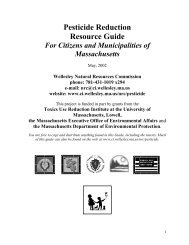Business Guide to Paper Reduction - Tufts Office of Sustainability
Business Guide to Paper Reduction - Tufts Office of Sustainability
Business Guide to Paper Reduction - Tufts Office of Sustainability
You also want an ePaper? Increase the reach of your titles
YUMPU automatically turns print PDFs into web optimized ePapers that Google loves.
Production Pollution and Resource Use: To create pulp for <strong>of</strong>fice paper, generally a<br />
kraft pulping process is used. This dissolves the wood chips and removes lignin, a<br />
resinous binding that gives structure <strong>to</strong> the cells <strong>of</strong> the wood but will ultimately cause<br />
yellowing in the paper if not removed. Overall, in this pulping process only about half<br />
the tree is actually used <strong>to</strong> make the paper. 28 Pulp and paper mills in the U.S. produce<br />
approximately 245,000 metric <strong>to</strong>ns <strong>of</strong> <strong>to</strong>xic air pollutants every year, which may include<br />
volatile organic compounds, sulfur, absorbable organic halides, chlor<strong>of</strong>orm, dioxin, and<br />
furan. All <strong>of</strong> these <strong>to</strong>xins have known health risks. 29 Worldwide, pulp and paper is the<br />
fifth largest industrial consumer <strong>of</strong> energy, accounting for four percent <strong>of</strong> the world’s<br />
energy use, 30 and the processes use more water <strong>to</strong> produce a <strong>to</strong>n <strong>of</strong> product than any other<br />
industry. 31 Overall, producing one <strong>to</strong>n <strong>of</strong> paper uses 98 <strong>to</strong>ns <strong>of</strong> various resources. 32<br />
Disposal Pollution: <strong>Paper</strong>, including paperboard, 33 is the single largest component <strong>of</strong><br />
municipal solid waste, constituting 38 percent <strong>of</strong> all materials. 34 As <strong>of</strong> May 2001,<br />
approximately 46 percent <strong>of</strong> the <strong>of</strong>fice paper generated in the U.S. was recovered. 35 Thus,<br />
despite long-term educational efforts, more paper is still going in<strong>to</strong> landfills than is being<br />
collected for recycling. 36 Once at the landfill, the carbon present in wastepaper<br />
decomposes <strong>to</strong> produce methane, 37 a potent greenhouse gas. The paper also has <strong>to</strong>xic<br />
printing inks on it. While printing inks have become less <strong>to</strong>xic over the years, many <strong>of</strong><br />
the color pigments are still made with heavy metals, which can eventually leach out <strong>of</strong><br />
the paper and contaminate groundwater through leaks in the landfill. 38<br />
This description <strong>of</strong> environmental problems is not comprehensive. To understand the <strong>to</strong>tal<br />
environmental impact <strong>of</strong> paper, a full life-cycle analysis would be needed, including fac<strong>to</strong>rs such<br />
as the transportation <strong>of</strong> trees <strong>to</strong> the mills and paper <strong>to</strong> the end-use destination, the extraction<br />
involved in the development <strong>of</strong> the chemicals used in production processes and printing inks, and<br />
the pollution in the production <strong>of</strong> those chemicals; among other fac<strong>to</strong>rs. Ecological degradation<br />
and potential health impacts from paper production should provide incentives <strong>to</strong> seek out better<br />
ways <strong>to</strong> meet the needs <strong>of</strong> business and society.<br />
D. Efficient <strong>Paper</strong> Use: Where the Environment and <strong>Business</strong> Intersect<br />
Regardless <strong>of</strong> whether a company approaches paper reduction from an environmental or<br />
economic perspective, the above-mentioned challenges can be addressed simultaneously. Even a<br />
cursory investigation <strong>of</strong> paper use will <strong>of</strong>ten reveal opportunities <strong>to</strong> reduce inefficiency. Possible<br />
approaches <strong>to</strong> these reductions vary in labor intensity and potential initial investment; some are<br />
simple, some are significant. Either way, businesses frequently find a high return on investment<br />
for their paper reduction efforts. As the examples below demonstrate, any scale <strong>of</strong> effort can<br />
result in worthwhile savings:<br />
Overall, producing one <strong>to</strong>n <strong>of</strong> paper uses 98 <strong>to</strong>ns <strong>of</strong> various<br />
resources.<br />
<strong>Business</strong> <strong>Guide</strong> <strong>to</strong> <strong>Paper</strong> <strong>Reduction</strong> 5







